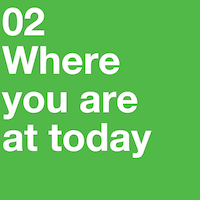Main Content

Diversity, Equity & Inclusion: 02 Assessing where your business is at today
You believe in the moral case for Diversity, Equity and Inclusion (DE&I) and support the business case for building a more diverse team. You agree creating an inclusive culture will form a better, more creative business which will align with the growing expectations of clients, and you understand you need to be clear on the legalities around DE&I*.
But how do you get started?
Taking an open and honest snapshot of the situation at your business today, and following a staged process which takes your team on the journey with you, are key to ensuring commitment is turned into tangible, manageable action.
Before jumping into action, it is sensible to gain a clear picture of where you are today. You will find strengths as well as opportunity areas. People within your business will have experience and ideas, and you will probably find you are already doing more than you think.
Do you already track diversity data? A good place to start is knowing where you are currently. Be aware that you need to adhere to the laws around gathering personal information and that disclosing data needs to be voluntary. Clearly explain to your team why you are asking for the information and the anonymous safeguards you will put in place around the data.
Individual perspectives
Encourage an open and honest conversation about DE&I with your team, find out current perspectives, ambitions and concerns. This can take some time and you may need to consider different ways of gathering views. Anonymous surveys can help reduce people’s concern about sharing their opinions. Employee Resource Groups (also known as ERGs, affinity groups or business network groups) can be an effective way of understanding the perspective of underrepresented groups and help promote an inclusive workplace.
Existing policies and procedures
Look at your existing policies, do you have an equal opportunities policy? How are complaints handled in the business? Are there policies in place for parental leave, accessibility or support for religious holidays? Are these policies lived by, or do they sit in a manual? What benefits are offered by the company? Are these tailored to specific groups, or do people feel they are broadly supportive and fair to all?
Is there a pattern of people leaving the company, or with people being promoted? Look at the records of exit interviews for people who have left to see if there is any pattern related to DE&I. If you do not conduct exit interviews, consider implementing them, or review how they are currently handled to identify opportunities for improvement. Review your performance appraisal process to assess whether it is fair and the judgement criteria for promotion is consistent across the business.
Are there any existing initiatives that are running within the business? Talk to your team about what they do informally. You may find people are already involved in initiatives or acting to create an inclusive culture. Building on what has already started is an inclusive behaviour.
Representation
What is the pattern of freelancers and suppliers you are using? Are broad cultures represented? When ideas come from a specific culture, is someone from that group benefiting from the work?
Taking an unconscious bias test is often a good starting point to help people understand the need for change. We all have some level of hidden bias as a result of our upbringing and the society in which we live; uncovering this can be the first step towards team members seeing a need for change. The free test devised by Harvard Business School is the most comprehensive and commonly used.
*Diversity is more than a nice to have, a number of characteristics are protected by law. Areas of law your business should be abreast of include, but are not limited to:
The UK Equality Act 2010: a legal framework to protect the rights of individuals and advance equality of opportunity. It protects individuals from unfair treatment and aims to promote a fair and more equal society. Watch a short video about the nine characteristics protected under the Act.
United Nations Convention on the Rights of Persons with Disabilities is intended to protect the rights and dignity of persons with disabilities. Parties to the convention are required to promote, protect, and ensure the full enjoyment of human rights by persons with disabilities and ensure that persons with disabilities enjoy full equality under the law.
European Accessiblity Act which will come into force from 28 June 2025. The Act reflects the commitment made by the EU when signing the United Nations Convention on the Rights of Persons with Disabilities. It requires some everyday products and services to be accessible for people with disabilities. Any digital product that operates in the EU will need to comply with the rules. The UK plans to adopt similar legislation.
General Data Protection Regulation: GDPR is considered the toughest data protection and privacy law in the world, it was created by the EU and implemented into UK law in the Data Protection Act 2018. It covers any data that allows a person to be identified. There are a few categories of sensitive personal data that are given greater protection, including information about racial or ethnic origin, political opinions, religious beliefs, membership of trade unions, genetic and biometric data, health information and data around a person’s sex life or orientation.
Web Content Accessibility Guidelines: WCAG 2 aims to provide a single shared standard for web content accessibility that meets the needs of governments internationally. Hitting AA standard is currently considered sufficient to comply with the European Accessibility Act and similar USA standards.
Do your research and seek expert advice where necessary. DBA members have access to a half hour of free legal advice and free employment law and HR advice on any number of subjects, through our helplines provided by Humphries Kirk and Croner. Find out more and access further guidance.
This guide was produced by the DBA’s Diversity, Equity & Inclusion Council – a group of experienced individuals drawn from across the DBA membership, working to strengthen DE&I in the design industry to create a diverse community whose instinct is to design for all. Through a commitment to DE&I and inclusive design, we can all contribute to a more welcoming, responsive and accommodating world.
Every business is different. These pages are a guide to key principles and best practice. They are designed to signpost you towards the types of resources that could help your business on its DE&I journey, but they are no substitute for working with an experienced, expert specialist who can fully understand your business and offer tailored advice.
These guides do not constitute legal advice and the DBA signposts to sources of other advice and information as a guide only.
